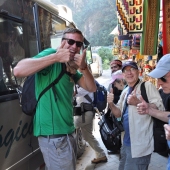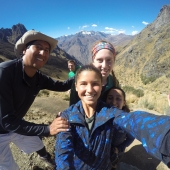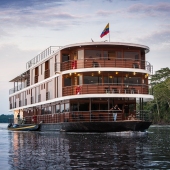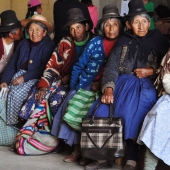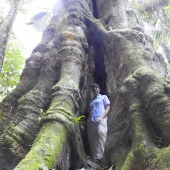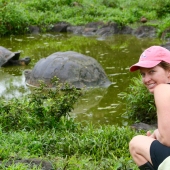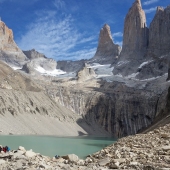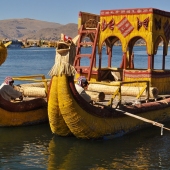Peru: my name is forever carved in their stove (part 9)
(continued from "Life in the Andean Lodge" part 8)
"Over the river and through the woods" (literally) were the homes of families who had been selected to be the recipients of 3 mud-brick stoves. More than just a fun activity for do-gooder Americans, the mud-brick stoves improve the quality and health of the lives of the Peruvian families in whose homes they are built.
Peppered over the mountains were the soil-colored, mud-brick homes of local families, 3 of which would receive stoves on this trip. Students were taught how to smooth out corrugated metal sheets usually used for roofing material. The flat metal sheets were rolled into long tubes that would be used to vent the stoves.
Smoke inhalation in the Andes mountains is a big problem with indoor wood fires. It mainly affects women who do the cooking, but also their babies and children, who stay with them until they are old enough to go to school. I noticed that in the home where I was working, the older woman had a chronic cough.
We were divided into 3 groups and a local tradesman with a couple of helpers guided each group out of the back of the lodge and up through the gulley, across a couple of potato fields, around a fence, through someone's "yard" and after about 45 minutes, we arrived into the center of a cluster of mud-brick homes, one of which would be the location for the stove.
It's possible the stress of the previous few days caught up with me, but on the way, I had to stop and sit down, because it was this 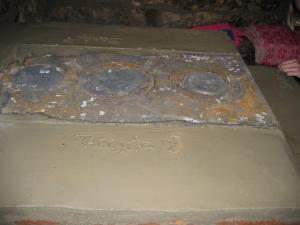 exact moment that my body decided to feel bad for a while. The tradesman's wife stayed behind with me, while the others continued to the home. The two of us settled against the damp rocks and she pulled off the woolen fabric that was wrapped across her back in the style of all the indigenous women. It was the Peruvian mountain woman's version of a purse. She pulled out her knitting, a skill that is practiced throughout the Andes, and sat patiently until I was ready to continue our hike.
exact moment that my body decided to feel bad for a while. The tradesman's wife stayed behind with me, while the others continued to the home. The two of us settled against the damp rocks and she pulled off the woolen fabric that was wrapped across her back in the style of all the indigenous women. It was the Peruvian mountain woman's version of a purse. She pulled out her knitting, a skill that is practiced throughout the Andes, and sat patiently until I was ready to continue our hike.
A few minutes later we arrived at the home where preparations for building the stove were being made. Smoke seeped through the thatched roof of one of the buildings. (If we saw that kind of thing in the states, we'd be dialing 911 to call for a firetruck.) The homes were positioned in a u-shape and everything was muddy. There was one rustic-looking, straight-back wooden chair which was offered to me as a throne to a Queen. The hut we were to build the stove in, was dark, dank and not livable by American standards. One rustic wooden shelf clung to the wall like a locust on a tree.
With the help of the experienced tradesman, we screened the sand, soaked the fired bricks and carried materials into the house, to be ready for assembly. Mortar was mixed by hand and the tradesman meticulously started the process of layering rocks, sand, bricks and mortar. Our work crew was comprised of the 3 females of our school group. The work was dirty but rewarding. The tradesman clearly knew what he was doing and gently guided the process. Members of the family were on-hand to help out. There were a couple of 8-10 yo boys, a 12 yo girl, a "grandmother" (who may have been my age, but looking much older, at least I hoped), a 20-something woman who carried a toddler on her back, a 5 yo girl and another middle-aged woman. Of course no one spoke English, but we weren't expecting it.
The one English-speaking guide we had went to another home with a group of our boys. My Spanish was the only link between us and the locals at this site. We could tell by the looks on everyone's faces, they were very glad we were there. Before we arrived, mules hauled up bags of sand, dried mud-bricks and the "plancha" which would be the crown of the stove. This was literally a big flat piece of iron (hence the reason it was called plancha, which means iron in Spanish) with three holes in the top with removeable plates. The iron was the actual cooking surface where pots and pans would be placed.
When the stove was finished and the vent had been installed, the family gave us a gift. A sack full of guinea pigs to take back with us for dinner! Mostly vegetarians, we gracefully accepted the gift, then fainted at the idea of eating these little creatures that we cuddled back in the U.S. After the tradesman had stroked the wet concrete for the last time, he gave us a long nail and motioned for us to scratch our initials into the wet surface. I was stunned at the idea that this family would forever have to look at my initials in their home! I reluctantly participated, suddenly feeling humbled by this moment. I scratched my first name and a heart. Would they be able to read it? Did they know what a heart-shape means? Even if they could not translate the meaning of my writing, I am sure they could translate my smiles and gestures. For a few hours we were all united by something much bigger than each of us alone. That's why we did this. (continue to part 10)


